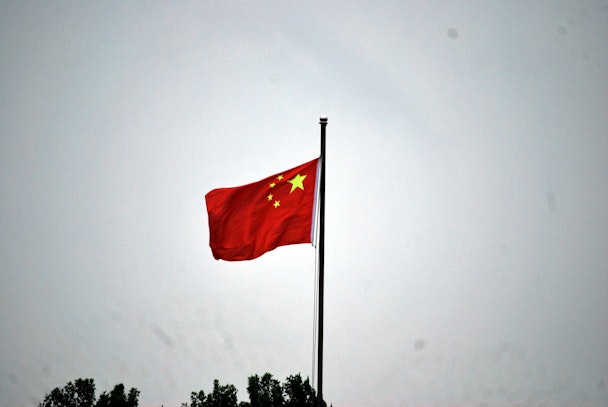Is China's creativity lagging behind other markets?
China had its best year ever at this year's Cannes Lions. The return of China Day, a host of Chinese speakers and companies – particularly tech giants Tencent and Alibaba, helped ensure the nation’s presence was felt on La Crossiette. However, while China’s technology and innovation were on full display, helping the country bag a record 13 Lions, when it came to more creative categories and topics, China was nowhere to be seen.

How can China boost its creativity?
Despite its sheer size and weight, China's medal haul put the country on par with Peru and Norway, and behind much smaller nations like New Zealand and Thailand.
The Drum spoke to some of China’s leading creative minds to get their views on the country’s creative prowess and how it can bolster its standing on the global stage.
While China's technology and innovation were standouts at the Cannes Festival this year, China's creativity continues to lag behind other markets on the global stage. Why is this?

Graham Fink, chief creative officer, Ogilvy & Mather China: “It’s true, that on a global scale, China is not yet ‘up there’ with the likes of the US or UK. One reason for this is the fact that China is still a relatively young market. Clients and agency skills are, on the whole, not as sophisticated as in the West and consumers’ skills at decoding semiotics and analogies (especially in the lower tier cities) are far from the developed ‘ad sense’ that our friends across the oceans have honed over years of watching great advertising. There are of course exceptions, and that’s when good work can get through. More and more clients from China are going to Cannes each year and coming back with their eyes opened. They really want to do great work and push not just the agency, but also their own people to raise the creative bar. And on that note about Cannes, I should point out that a lot of work done in China works incredibly well here, but would be lost on an international jury. The real judges are the Chinese consumers.”
Tian It Ng, chief creative officer, McCann Worldgroup China: “If the benchmark is the number of Lions won, then indeed there’s some catching up to do. The sheer size of China means that creativity does take on, perhaps, a far more practical role, because business targets achieved can have an exponential impact. In other words, the world needs China to work. When the stakes are this high, the challenge often remains on how to keep the idea pure and single-minded. The country has progressed at such breakneck speed that we often tend to construe it as a finished article. In truth, it’s still at a nascent stage as a global player. It’s all about developing as we go. Hence, perhaps there is a certain lack of depth and vision, both essential for world-class creativity.
Rocky Hao, executive creative director, Leo Burnett Shanghai: “I think there are several reasons for this. First off, China has very rigorous censorship on advertising. Many sensitive topics, for example, homosexuality, or competitive content against peers, are prohibited. This is a very big constraint on creativity, ideas and innovation. Another thing is that rather than taking a risk on avant-garde ideas, Chinese clients lean towards advertising which can guarantee safe – or at least a non-controversial feedback from the public.”
Leong Wai Foong, chairman & chief creative officer, BBDO Greater China: “As an adman working in China, it is great to witness China’s Technology brands like Baidu, Alibaba and Tension, joining the global players like Google and Snapchat and taking a prominent stage at the Cannes Festival this year. But the sad part is, China's creativity is still lagging behind other markets on the global stage.”
Is China's creativity lagging behind other markets?

Tian It Ng: It really depends on perspectives. In award terms, probably yes. But this is not the only measure of creativity. Real work that moves the dial for real clients deserves recognition too. China is a very unique market that calls for its own unique brand of creativity. It reminds me a lot of Japan, many years ago, when their work struggled to breakthrough in the international award shows. It took a journey of cultural appreciation on both sides – Japanese creatives and international jurors, for Japan to make its presence felt. I think the same applies to Chinese work today.
Rocky Hao: “Compared to the creative industries in Europe and the States, China still has a long way to go. Unlike countries that have developed distinct styles like Japan, Thailand and Brazil, China is also still imitating and referencing others without developing an original style of its own.”
What are the reasons for this?

Leong Wai Foong: “In my humble opinion, this is because we have confused ourselves between creativity in technology and innovation, versus creativity in brand communication. Put in a simple form, creativity in technology and innovation is how to reach your consumer; creativity in brand communication is what to show your consumer.
"Take the WeChat app developed by Tension, as an example. It has become a super app that covers almost every aspect of the daily life of a Chinese consumer, which is excellent creativity in technology. But when brands in China are spending most of their effort and budget to work with the channel built by WeChat, they’ve neglected the content of their communication, which leads to the mediocre creativity in brand communication.
“Due to the huge population in China, brands with mediocre creativity (or bad creativity to a certain extent) are still enjoying demographic dividends, which make it harder for brand owners to detect the issue - the investment the brand owner has made, is, in fact, building the branding for the technology company, rather than their own.”
Rocky Hao: Most of China’s TV commercials still focus more on introducing the functions of the client’s products or services, to give audience a basic education rather than building an emotional connection with the audience
What are your perceptions of China's creativity compared to other markets?
Tian It Ng: “Not world class yet for sure, but certainly not doomsday either as portrayed by award results. To me, awards are just one way to measure creativity. And like everything else in life, they have their own rules. China is still learning the ropes in every sense of the word, with awards being one of them. China is vibrant, dynamic and has a can-do spirit, which will swiftly shift the state of creativity. It also has the desire to be the best, which will go a long way in accelerating the push for excellence. And unlike many other markets, it possesses the financial muscle and market size to actually make it happen.
What is driving China's creative industry?

Rocky Hao: “Talent. We are only as good as our people. However, the brain drain has been a very severe problem in the China advertising industry. Many senior advertising people have job hopped to Internet companies. And advertising agencies are no longer the first choice for most college graduates.”
Graham Fink: “Four things: 1. Money: It is possibly the only creative industry that puts money at the front of creativity.
2.Progress: The constant invention of the new. In spite of being so nascent, the industry has been one of the most agile to adopt new technology and bring creativity into it. Right from social to m-commerce… WeChat, Weibo, and I believe will possibly be the first to find a mainstream use of AI for creativity.
3. Face: for self, client, society, country. So, in advertising, you see similar looking ads that shy away from deep point of views and always tend to follow a pattern of harmony, scale and celebrity.
4. Hotpot. The boiling up of censorship, youth and technology will create the next wave of ingenuity in creativity in China.”
Tian It Ng: “No market is more diverse and complex than China. There is so much to navigate here with cultural nuances, different corporate managerial styles and regional variations. Thus, to create a campaign here requires many times the effort as compared with other countries. Especially if the goal is not to go for the lowest common denominator. It is very important to understand the rigours of the business as clients have no tolerance for anything less. Whilst it may take some time to create work that resonates with international juries, the quality of day-to-day output has already shown healthy signs of progressing from strength to strength.”
What could help infuse more creativity into the marketplace?
Graham Fink: “Creativity is at its best when it’s pushing boundaries and challenging people. Work that you look at and say ‘how on earth did they manage to sell that to the client?’
"Take for example the Burger King print work that won a Grand Prix at Cannes. Photographs of Burger King stores burning down as a result of flame grilling their burgers. That takes an agency with creative mischief and then courage to go and present it to their client. I know many account handlers who wouldn’t want to handle that. They’d worry the clients would freak out and fire them. It also takes a very ballsy client to buy it. I can imagine that being done here and our client would say it’s too negative, putting peoples lives in danger and “you’re destroying our product for god's sake!”
"But it’s creative work like this that cuts through the humdrum and mundane content we see on our screens, in our magazines and on billboards. So, we need more bravery and audacity on the agency side and more clients like Burger King.”
Tian It Ng: “A need to do something different, given a drastic change in market forces. We are inherently a very pragmatic breed that will tend to stick to what’s working unless what’s working is not working anymore. The luxury of more time. It will help, particularly on honing craft and thinking. A wider literacy of the English language among the creative community will also help immensely in opening up both minds and horizons.”
Rocky Hao: “We should encourage more international exchange to acquire creative inspiration and latest technology from around the globe. Meanwhile, we have to be more introspective and look deeper into our cultural heritage, and into consumer behaviour for in-depth insights.”
Is the China market more focused on technology and innovation over creative ideas?
Tian It Ng: “Yes and no. I like to use this analogy. Technology and innovation are hardware that can bring immediate, tangible results. Whereas creative ideas are software that is more nebulous, intangible. Hardware appears easier to hone, but software requires an evolved level of taste and judgement, so is harder to sell to clients. However, the competition for share of view on social media is shaking things up with more and more marketers willing to try something different."
Rocky Hao: “Ideas and concepts still matter the most. Technology and (channel) innovations are merely about execution. The top priority should still be on digging deep to get consumer insights and communicating with consumers in a moving story telling way.”
How do you think China's creativity will evolve over the next few years?
Tian It Ng: “I’ve no doubt that it will become better, wiser and smarter given the maturing of everyone at play in the process. At present, not many see the merit of fame that award shows can bring, which is why a certain trait is required - hunger. If this hunger to win and be internationally recognised is revved up on a wider scale, there’s no telling how far China will go.”
Graham Fink: “Hopefully it will continue to grow. There are pockets of brilliance here and there but it needs to be more consistent. Hopefully, more craft will develop in the work. But for that you need time and that’s one thing nobody seems to have.”
Leong Wai Foong: I am still optimistic about the China market, cause the youth consumer in China will become more and more sophisticated. While their desire towards excellent creativity in technology will never end, they will eventually look for brand with solid and unique content too, which is excellent creativity in communication. We just have to keep doing the right thing and make sure we are there when they reach that stage."
Rocky Hao: “The future is bright. Though the way to achieve that goal is still full of twists and turns.”
See more from The Drum's coverage of this year's Cannes Lions Festival of Creativity at the dedicated online section.

